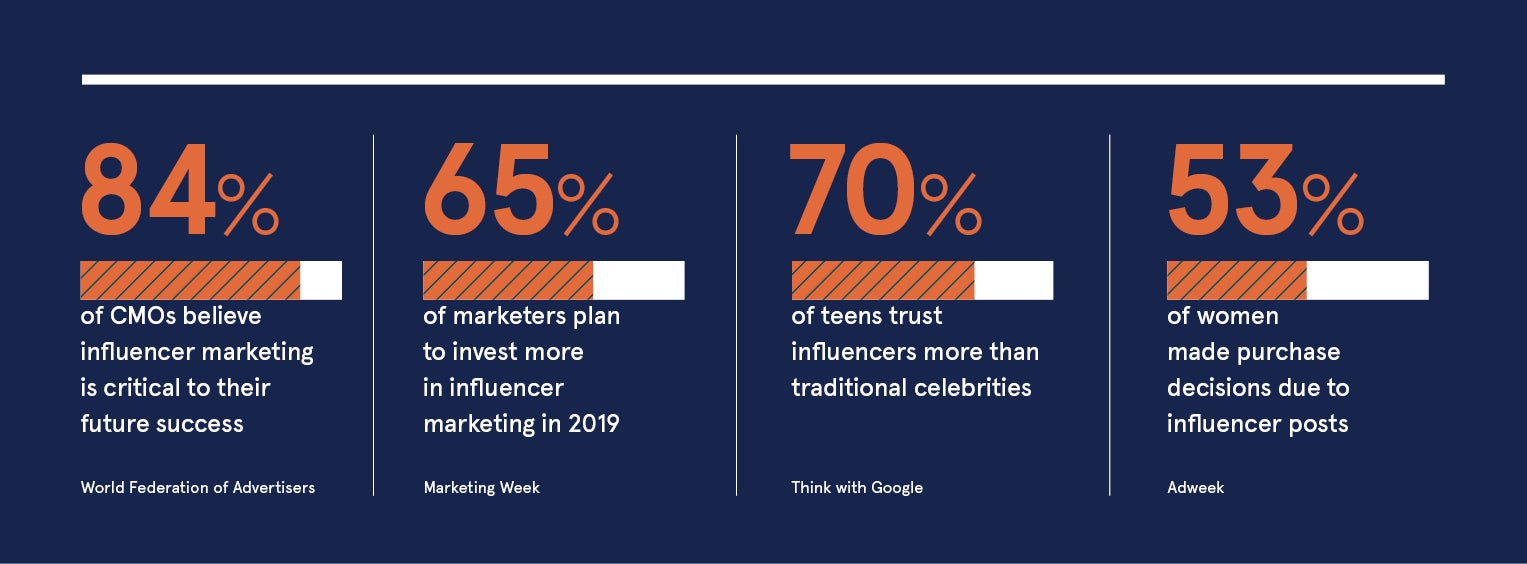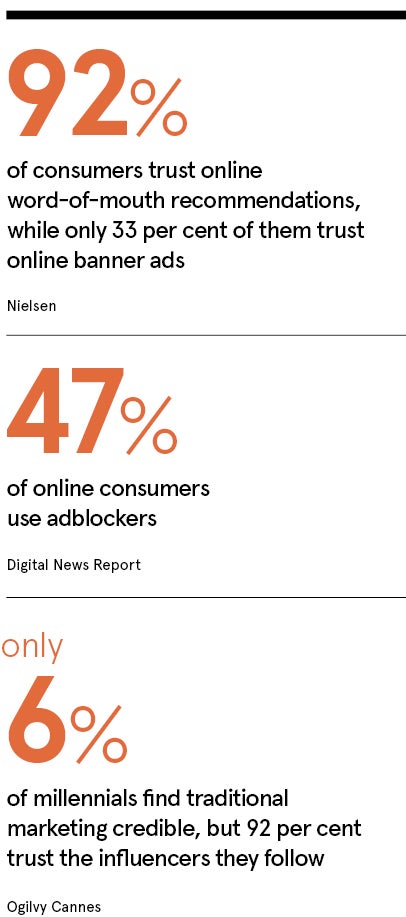Poet Mary Oliver famously said: “Attention is the beginning of devotion.” And she had a good point. What we turn our attention to is based on what we’re interested in, inspired and entertained by or care about. Over time, this attention transforms into devotion. We devote ourselves to a TV show, an influencer or a brand, and devotion is the Holy Grail for brands.
Right now, consumers tailor their media consumption based on their interests and needs to a much greater extent than in the past. What they view in their social media feeds is completely up to them. To become part of this, brands need to take part in the conversation and the content that entertains and inspires consumers. And no one inspires and engages, and consequentially gets the attention of people, like influencers.
Why, because people trust people. It’s nothing new, it’s word of mouth. We all know that we trust people more than billboards, TV screens and pop-up ads, but do the results prove it? And can it scale? The answers: yes and yes.

New studies keep proving how efficient this medium is. Across Tailify’s 2,500 influencer campaigns, the ad sponsored content gets on average 20 per cent higher engagement than the influencer’s non-sponsored content. It’s like watching a movie on television and fast-forwarding to the commercials. It’s not just attention, it’s effective attention. To date, the average return on investment (RoI) for influencer marketing campaigns is more than six times, according to the Digital Marketing Institute.
The market supply, with more than 51 million influencers globally, makes influencer marketing the biggest ad inventory the world has ever seen.
Brands are waking up to this and influencers are increasingly essential in the marketing mix. It’s why the influencer economy will be worth $10 billion by 2020 and is set to grow.
Those who take influencer marketing seriously are rapidly taking market share from large legacy brands around the world
Some 89 per cent of brand managers surveyed say influencer marketing impacts how people feel about brands, according to research from eMarketer. For many startups it’s a cost-effective way to get their product in front of audiences. In fact, influencer marketing is still heavily underpriced and is a fraction of what’s spent on television, newspaper or magazine advertisements.
“Influencer marketing has been incredibly effective in engaging audiences globally in the last few years; it’s why the C-suite take it seriously. We now have a voice at the table when it comes to marketing budgets, with chief marketing officers realising influencers are critical to success,” explains Fredrik Segerby, co-founder and chief executive of Tailify, one of Europe’s leading influencer marketing agencies.
 A perfect storm is also hitting many industry sectors, whether it’s retail, banking, health and beauty, fashion or consumer goods. A legion of digitally native and challenger, direct-to-consumer brands are disrupting how products are sold and purchased. They’re using influencer marketing as their primary form of attack.
A perfect storm is also hitting many industry sectors, whether it’s retail, banking, health and beauty, fashion or consumer goods. A legion of digitally native and challenger, direct-to-consumer brands are disrupting how products are sold and purchased. They’re using influencer marketing as their primary form of attack.
Just look at Daniel Wellington, the watch on every influencers’ arm, that has become one of the world’s biggest watch brands in just six years. Or Kylie Jenner cosmetics that sold make-up worth $420 million in 18 months, leaving traditional beauty brands with dropped jaws. At the same time, legacy brands are playing catch-up in the process.
If Tailify is a bellwether for the rise of the influencer economy, then it’s reflected in its growth. Founded in 2013 in Stockholm, the company moved to London in mid-2016; since then it’s gone from three to twenty-four employees. Their influencer network has mushroomed by 7,000 per cent, delivering more than 2,500 campaigns, while tracking over two billion data points. It’s now a full-service influencer marketing partner backed by UK’s Founders Factory, Germany’s Axel Springer and L’Oréal.
“Influencer marketing is no longer the Wild West; we are gradually taming it. Our number-one goal is to professionalise and improve the influencer economy, by taking a cold-headed and warm-hearted approach. We do this by combining data, technology and science with creativity, emotions and experience,” says Mr Segerby.
Perceptions of the influencer economy and campaigns still lag behind the reality, and nowhere is this more apparent than when it comes to data and accountability. The fact is campaigns can now be carefully calibrated, measured using sophisticated tools and tracked with full transparency. It’s one of the only marketing disciplines where you get instant feedback in terms of likes or views. Data about an influencer’s reach, brand affinity and the demographic of their followers can also all now be shown.
“Many companies still undervalue the medium, as well as perceive it as risky. When you look at the RoI, as well as the performance and the affordability of an influencer campaign, you really have to ask yourself why brands aren’t doing a lot more. Social media fuelled by influencers is an extremely powerful marketing tool; you will sell products,” explains Tailify co-founder Fredrik Martini Andersson.
“Marketing buyers are more comfortable with traditional media and don’t want to upset the status quo, but this is changing as we build more trust in influencer campaigns. Companies of all sizes, whether they’re digital startups or legacy companies, need to leverage the power of influencers to win in a competitive market.”
With a saturation of influencers globally, building a substantial social media following on Instagram, Facebook or YouTube and successfully monetising isn’t easily achieved. The market is competitive, requires skill and hard graft. In the process, influencers are becoming more creative and discerning in terms of the companies they team up with.
“If you’re not relevant or entertaining as an influencer, people ‘unfollow’ you. It’s as simple as that. The economy is therefore increasingly regulating itself. If influencers aren’t authentic or co-creating with brands in an inspiring way, they don’t stay influencers for long,” says Mr Segerby.
“The industry is certainly more professional, transparent and sophisticated. Those who take influencer marketing seriously have won market share from large legacy brands around the world. We advise every chief marketing officer to give it a seat at the table and to fight for a place in their marketing plan.”
For more information please visit Tailify.com


